Guilford Historic Town Center facts for kids
Quick facts for kids |
|
|
Guilford Historic Town Center
|
|

First Congregational Church
|
|
| Location | Bounded by West River, I-95, East Creek and Long Island Sound, Guilford, Connecticut |
|---|---|
| Area | 1,752 acres (709 ha) |
| Built | 1639 |
| Architectural style | Greek Revival, Colonial, Federal |
| NRHP reference No. | 76001988 |
| Added to NRHP | July 6, 1976 |
The Guilford Historic Town Center is a special area in Guilford, Connecticut. It's like a big outdoor museum! This historic district covers the entire town center.
It's famous for its town green, which was first laid out in 1639. The district stretches from Interstate 95 in the north to Long Island Sound in the south. It also goes from the West River in the west to East Creek in the east.
More than 600 old buildings are found here. Most were built between the late 1600s and early 1900s. These buildings show how the town grew over many years. In 1976, this area was added to the National Register of Historic Places. This means it's officially recognized as important to history.
The town center is also known as a census-designated place (CDP). This is a special area defined for gathering population data. In 2010, about 2,597 people lived in the Guilford Center CDP. The whole town of Guilford had 22,375 people.
Contents
Exploring Guilford's Past
How Guilford Began
English settlers from the Connecticut Colony founded Guilford in 1639. They bought the land from Native Americans. Right away, they planned the town green. For a long time, Guilford's economy relied on farming and fishing.
Later, in the late 1700s and early 1800s, shipbuilding became popular. But Guilford didn't have much industry. Today, it's mostly a quiet residential community.
A Look at the Architecture
The town center shows off many different building styles. This is because it grew slowly over 300 years. You can see buildings from different time periods.
Most of the old buildings are still there. Only U.S. Route 1 and the late 1800s railroad tracks have changed the area much.
What You'll See Today
The historic district covers about four square miles. Near the edges, you can still see salt marshes. These remind us of the town's farming past.
One very special building is the Henry Whitfield House. It's Connecticut's oldest stone house, built in 1639. Today, it's a museum. Henry Whitfield was the town's first minister. People used to hold church services in his house.
The town green looks almost the same as it did in 1639. Old and new buildings line the green. You'll find shops, town offices, and churches there. The current Congregational church, at the north end of the green, was built in 1829. The town hall is on the east side. It was built in the late 1800s.



